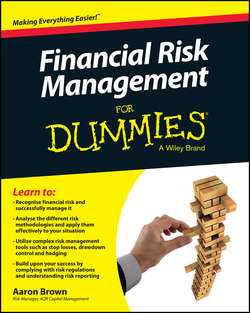Читать книгу Financial Risk Management For Dummies - Aaron Brown - Страница 2
На сайте Литреса книга снята с продажи.
Introduction
ОглавлениеRisk management is about preparing for anything that might happen. People who try to predict the future are the enemies of risk management. They’re the ones who say, ‘Let’s build a wall on the north side of town because that’s where we predict the attack will come.’ Risk managers know that leaving any gap in the wall means the attackers will exploit the gap.
Preventing disaster is easy – you just don’t take any risk. Risk management is about surviving disaster, not preventing it. If there weren’t disasters, you wouldn’t call it risk. You need risk – and its attendant disasters – to learn, to grow, to excel.
If you want to be a risk manager, this book gives you a good start. You need practice at risk taking, plus some maths and financial theory, plus some practice at finance. If you already have all of those things, you should be writing this book, not reading it.
About This Book
People have been concerned about risk as long as there have been people. Financial Risk Management For Dummies explains the background and some theory about risk, quantitative analysis of risk and modern financial risk management and shows you how to apply them in practice, without jargon or mathematics. Okay, I throw in a few examples that require addition and multiplication, but they’re clearly labelled and can be skipped, and I also give you lots of simple, specific illustrations.
This book tells you what financial risk managers do and why they do it.
Foolish Assumptions
I make three different guesses about who you are and why you’re reading this book:
✔ You’re currently, or hope to be, a financial manager, and you want to delve into the risk management aspect of your job. By itself, this book cannot teach you that, but if you already know the basic financial theory and mathematics or go elsewhere to discover them, this book can show you how to apply them properly to become a good financial risk manager.
✔ You work with financial risk managers and want to understand how they see things. This book can show you the world from their perspective, and help you form constructive partnerships.
✔ You have no professional connection to finance, but want to understand both the good risks in finance, the ones that help the economy grow and people realise their dreams, and the bad risks in finance, the ones that damage the economy and blight lives. This book can help you navigate the modern financial system to achieve financial security.
Icons Used In This Book
These little pieces of margin art bring your attention to exceptionally interesting or useful information. That is, except for text next to the Technical Stuff icon, which is information – usually maths – you may find helpful if you’re interested.
Simple, standalone advice that you can take to improve your risk management.
Standalone stuff it pays to keep in mind.
Stuff I love and the For Dummies editors don’t has this icon. You can skip it if you want, I promise all the important ideas are explained clearly in non-technical language elsewhere. But come on, this stuff is really fun and a little maths won’t hurt you.
This icon marks stuff not to do. In risk management, if you do something you’re not supposed to, it isn’t usually actually dangerous. This icon marks situations that may seem attractive in the short run but that defeat the long-term goals of risk management.
Real-world scenarios, and sometimes real-life maths, get this icon.
Beyond the Book
Risk is a big topic, too big to fit entirely into the book or e-book you’re holding at the moment. I put some additional material on the web. I created cheat sheets (www.dummies.com/cheatsheet/financialriskmanagment) with the key ideas for managing seven specific kinds of risk:
✔ Market risk: Uncertainty due to changes in market prices.
✔ Credit risk: Uncertainty due to a failure of an external entity to keep a promise.
✔ Operational risk: Institutional uncertainties other than market or credit risk.
✔ Liquidity risk: Uncertainty about terms and the ability to make a transaction when necessary or desired.
✔ Funding risk: Uncertainty about whether investors will provide sufficient funds.
✔ Reputational risk: Uncertainty about how your entity will be perceived.
✔ Political risk: Uncertainty about government actions.
I also stick in some concentrated summaries of four sections of this book: Measuring Risk, Communicating Risk, Managing Risk and Working as a Risk Manager. You can also access bonus material at www.dummies.com/extras/financialriskmanagement, including ten great links that illustrate ten financial risk management lessons is amusing and dramatic fashion, from killer molasses to an Olympic David versus Goliath tale.
Where to Go From Here
If you know nothing about finance or risk and want to be a financial risk manager, I recommend reading this book in order. But, you can jump around to whatever chapters and sections seem interesting. Switching back and forth between theory and practice, between high-level views of the forest and detailed descriptions of individual trees may be the best way to understand what modern financial risk management is all about.
If you know nothing about finance, risk or financial risk management and are walking into work for your first day as a financial risk manager of a major global bank, turn straight to Chapter 10 and follow the directions step-by-step through to the end of Chapter 13.
If you’re really in a hurry, turn right to Chapter 20 and get all the really important stuff in ten minutes. Not ten minutes to read, ten minutes to read and do!
Wherever you start, I trust you’ll find information you can put to use.
